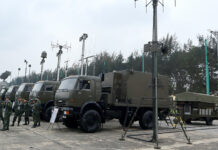U. S. intelligence agencies believe China performed the anti-satellite (ASAT) test January 11. During the test, a kinetic kill vehicle, launched by a ballistic missile destroyed a target orbiting earth at an altitude of 537 mi (864 km). The Chinese test was similar to a test of a kinetic energy ASAT weapon carried by the U.S. in 1985, destroyed a U.S. scientific satellite in orbit at 326 mi (525 km) altitude. The destruction of the weather satellite left considerable space debris in a heavily crowded orbit around 900km, used by many commercial, scientific and military satellites.
The target of the recent Chinese test was identified as the Feng Yun 1C spacecraft, an aging Chinese weather satellite. The exercise signifies a major new Chinese military capability. According to intelligence reports, China tested laser countermeasures to blind US reconnaissance satellites passing over China. It was reported that for the past several months, Chinese lasers have been “illuminating” US spy satellites. This recent demonstration signifies the maturity and breadth of China’s military capabilities in space. According to Aviation Week, which broke the story last Wednesday (Jan. 17, 2007) the current Chinese capability is more of a “policy weapon” at this time, but the test shows that the Chinese military can threaten the imaging reconnaissance satellites operated by the U. S., Japan, Russia, Israel and Europe.
“The point is that live ASAT weapons testing in space – be it at a low earth orbit (LEO), a medium earth orbit (MEO), or a geostationary earth orbit (GEO) – has a potential to damage or destroy a lot more than merely the intended target,” says Marco Caceres, lead analyst for Teal Group’s World Space Systems Briefing. “The event likely added hundreds of trackable debris objects and tens of thousands of small particles to the growing problem,” he said. According to estimates by the TEAL group, there are about 175-200 LEO commercial satellites currently in operation, in addition to military and scientific satellites and the International Space Station (ISS). David Wright, co-director of the Global Security Program at the Union of Concerned Scientists, adds that the altitude of this test was a particular concern, because of the low atmospheric density at that altitude, half of the debris larger than one centimeter would remain in orbit for a decade or longer.
This thrust will undoubtedly intensify the US Pentagon and Congressional interest in “space control”. China’s growing military space capability is one major reason the Bush Administration last year formed the nation’s first new National Space Policy in ten years.
Because kinetic energy ASAT weapons destroy satellites by colliding with them at very high speeds, their use creates large amounts of space debris, which can remain in orbit for very long times and threaten other satellites. The Chinese satellite that was destroyed had a mass of 750 kilograms and was orbiting at an altitude of 850 kilometers. The collision would be expected to completely fragment the satellite into millions of pieces of debris: nearly 800 debris fragments of size ten centimeters or larger, nearly 40,000 debris fragments with size between one and ten centimeters, and some 2 million fragments of size one millimeter or larger. At the very high speeds these debris particles would have, particles as small as one millimeter can be very destructive. While shielding on satellites can help protect against small particles, most satellites do not carry such shielding. Moreover, shielding is not effective against debris larger than about one centimeter in size.
















